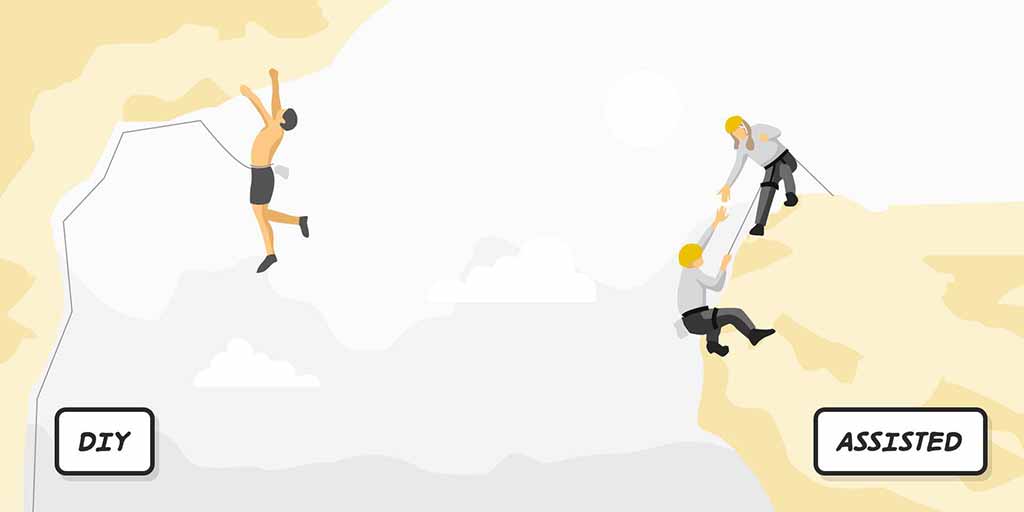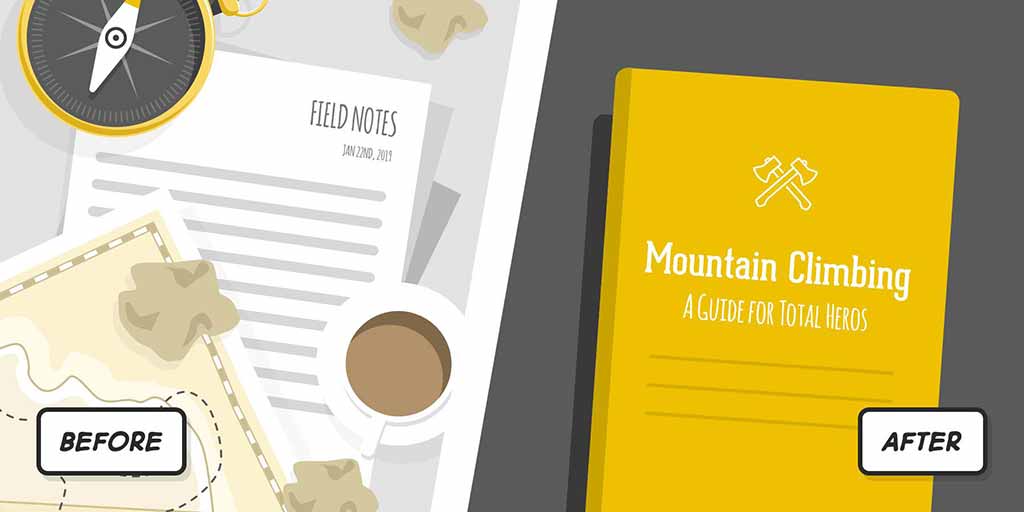How to Self-Publish a Book in 2022: 7 Steps to Bestselling Success
Learning how to self-publish a book and getting your ideas into the world is easier than it’s ever been. There is a wealth of knowledge available online, shared by authors who have developed proven techniques for selling more books. There are also a number of ways new authors can access professional services without breaking the bank.
Here’s how to get a book published in 7 simple steps. But first, let’s go back a ways…
A History of Self-Publishing

By self-publishing, we generally mean creating and selling a book online, outside the traditional publishing industry — in which publishing companies pay authors advances and a royalty, working with them to edit, design, and distribute the book.
Today, anybody with an internet connection can write an ebook and make it available to hundreds of millions of readers — pretty much for free. The new challenge is to make these books bestsellers without the marketing might of a HarperCollins behind them. Many writers have risen to this challenge, however, with the help of modern methods and social media.
The current stars of self-publishing include:
- E.L. James, whose Fifty Shades books were initially self-published as hot-and-steamy Twilight fanfiction.
- Hugh Howey, the American sci-fi author whose novel Silo became a bestseller when it was self-published as a series of novellas.
- Guy Kawasaki, the Silicon Valley tech evangelist whose book APE: Author, Publisher, Entrepreneur laid out many principles authors now use to find publishing success.
But what defines true success in publishing? If it’s the ability for authors to support themselves as full-time writers, you might be surprised to learn that this is often easier without a publisher — for reasons you’ll discover in the next section.
Advantages of Self Publishing: Bypassing the Gatekeepers

There are many benefits that draw authors to self publishing. Without having to go through the traditional gatekeepers of the publishing world, you will find:
- Creative freedom. You have full control over the content, the title, the length, and the book cover design. You have the option to collaborate with editors and designers — but in the end, the only editorial approval you’ll need is your own!
- A guarantee of publishing. If you need to release your book by a certain date, pretty much the only way to guarantee it is to publish it yourself. After all, you’re not beholden to the schedules of a gargantuan press.
- A greater portion of royalties. By essentially cutting out the middleman, the self-published author will retain all the proceeds (minus the retailer’s cut).
- 100% ownership of rights. As part of their book deals, traditional publishers sometimes ask for exclusive rights to reprint, film adaptations, and merchandising. The independent publishing route at least ensures you remain in full control. To learn more about self-publishing vs. traditional publishing, check out that post, or the learning course below!

DIY vs. assisted routes
Almost all independent authors choose one of two routes: DIY or Assisted.
DIY: This is where the author does everything by themselves, including the editing, designing, and marketing of their books. There are few (if any) people who can do all of this well, as many parts of the publishing process are usually overseen by professionals with years of experience in the field. Doing everything to a professional standard by one’s self is next to impossible.
Assisted: Those who self publish can choose to work with freelance editors, proofreaders, designers, and marketers on their book. Because they tend to work with limited budgets, prudent independent authors will learn and do as much as they can by themselves before bringing in the pros to take care of everything outside their expertise.
How to Self-Publish a Book in 7 Steps
In this section, we’ll give you the whistle-stop tour. We’ll show you what we believe to be the simplest method for publishing a book independently, while also providing you with the resources to learn more if you want.
Here are seven steps to publish your book (the indie way):
- Write a book that somebody wants to read
- Edit the manuscript (with a professional)
- Design the cover and format the interior
- Decide on print, ebook, or both
- Master the Kindle store (and other retailers)
- Market your book effectively
- Create a laser-focused launch plan
1. Write a book that somebody wants to read

An author with an advance, an agent, and a regular editor will have a support team in place to guide the first draft. But by and large, the process of writing a manuscript is the same for any author: with a little planning and discipline, any author can learn how to write a book (or how to write an ebook).
The first thing you need to do is plan your first draft. However, this plan will depend on what kind of book you’re writing:
1. Non-fiction
When you’re writing a non-fiction book that’s either a how-to book, or a title that aims to solve a readers problem, the planning might include:
- Research and interviews to develop content, and
- The creation of a “book proposal.”
A book proposal is a document that shows publishers what the end result of a book will be. Needless to say, they’re very common in the traditional publishing industry. However, more independent non-fiction authors have recently found it a useful to create one as well — to ensure that their book stays on message and delivers. To get a sample template, check out this guide to writing a book proposal.
2. Memoir
While also based on true events, memoirs require a slightly different approach than other non-fiction books. Unlike most other types of non-fiction, memoirs tend not to offer solutions to a reader’s problems, but simply to tell a story. If you’re writing about your own life, check out this guide to outlining a memoir.
3. Fiction
In the prep phase, most fiction writers will lay some groundwork and develop the world of their novel, sketch out their characters, and map the plot. To learn more about planning a novel, check out these articles:
- What is a Narrative Arc? – A breakdown of your protagonist’s journey, as influenced by the three-act structure.
- Dynamic Characters: How to Write a Compelling Protagonist – A look at how to write a compelling protagonist that is grounded in reality.
- First, Second, and Third Person: Which Point of View is Right for Your Book? – Find out how to choose which perspective might best serve your story.
- Worldbuilding Tips from the UK Editor of The Martian – Editor Michael Rowley breaks down the basic of worldbuilding, focusing not only on sci-fi and fantasy but in all commercial genres.
Create a routine
Finding the time to write is an enormous challenge for authors — especially those who have to balance a full-time job and family obligations. To make sure you don’t lose momentum and interest in writing, you need to establish a sustainable writing habit that works with your schedule.
- How to Create a Regular Writing Habit – Author and book coach Kevin Johns reveals his process for creating a writing schedule that will work around your life.
- Stop Procrastinating! Build a Solid Writing Routine (Free Course) – Using cutting-edge behavioral science, this course aims to help writers kill their procrastination gremlins.
- How Long Does It Take to Write a Book? – All about how long you can expect this process to take, and how to cut down your writing time as much as possible.
Whatever you need to get that routine started, make sure you do it. If it means not treating yourself to a muffin until you’ve written 3,000 words in a week — do it. If you need to schedule every single hour of the day to ensure you can steal enough time throughout the week to build momentum, then make it so.
Perfect your craft
Writing a book is like developing any other skill: it requires time, effort, and a willingness to learn. If your goal is to be a better writer, make sure you’re always learning from your mistakes and building on them.
- How to Write a Novel – A comprehensive course by indie novelist Ben Galley.
- How to Write a Memoir – Tips from bestselling ghostwriters on writing a life story.
- Writing Dialogue – Ideas and exercises to bring your story to life.
- What is the Theme of Your Story? – How to identify and include underlying meanings in your book.
2. Edit the manuscript (with a professional)

Editing is a pretty broad term. It can range from an author’s rewrites of their first draft to the final proofread before the book launch. In this section, we offer our recommended approach to editing your book for self publishing.
Self-edit as much as you can
An editor’s time is money: your money. Before you hand your work off to a professional, make sure you do everything you can for it — or you’ll just end up wasting money paying an editor to clean up basic mistakes.
If you’re a novelist, that might mean working through a few drafts to iron out the story and characters; for non-fiction, that might mean sharing the manuscript with a focus group and re-writing it based on feedback. Here are a few resources to help you revise and self-edit your manuscript:
- Chapter Length Matters and How Long Should Your Novel Be? – Two posts that explain the importance of understanding the average book and chapter lengths in your genre.
- What to Expect From Beta Readers And Where to Find Them – An introduction to getting fresh (and free) eyes on your manuscript.
- What are Sensitivity Readers? (And Should Authors Use Them?) – An article on the controversial topic of sensitivity readers that peels back the curtain as to what they actually do.
- Novel Revision: Practical Tips for Rewrites (Free Course) – A 10-part course that includes great lessons on working with critique partners and beta readers.
- How to Self-Edit Your Manuscript Like a Pro (Free Course) – Tips on how to spot the ten most common writing mistakes.
Let a professional help you over the finishing line
Once you’ve taken your manuscript as far as you can by yourself, it’s best to bring in a fresh pair of eyes. These days, finding your ideal editor is more straightforward than ever.
Before getting too far down the editing rabbit hole, it’s important to understand the different types of editors, and what each of them does.
- What Can Authors Expect From Their Fiction Editor? – This post explains crucial differences between developmental editors, copy editors and proofreaders. It focuses on fiction, but the principles broadly apply to non-fiction and memoir too.
- What Is an Editorial Assessment? — A quick look at how authors can get help with their book’s ‘big picture’ without paying for a full developmental edit.
3. Design the cover and format the interior

When we talk about book design, the first thing that jumps to mind is the cover — and for good reason! Self published authors rely heavily on a book cover for sales, whether it’s with ads or just by attracting readers on retailers like the Kindle store. It’s also important not to forget about interior design: the way that the words are formatted on the page.
Here are a couple of great resources to help you wrap your head around making a beautiful, readable book:
- Book Cover Design: A Definitive Author’s Guide – Includes a description of different book design methods and the best way to hire professional cover creators.
- Book Cover Maker Apps: 7 Resources to Design Your Own Cover – A list of free and low-cost tools DIY publishers can use to make a cover.
- What is Typesetting? – A comprehensive look at interior book design.
- How to Format a Book with the Reedsy Book Editor – A quick introduction to a tool that lets authors format professional-grade book files for free.
- The Back of a Book Cover: How to Build One That Actually Works – Includes a template to make sure the back of your jacket meets the basic requirements.
Once you’ve completed the step of designing and formatting, you will have everything you need to start selling your book. That takes us to our next stage.
4. Decide on print, ebook, or both
In days past, self-publishing a book involved getting a print run and paying up-front for thousands of copies. You pretty much always ended up with copies that you couldn’t sell. Thankfully, modern publishing has provided simple solutions to this problem!
If you’re looking for the simplest solution, here it is: just publish your book with KDP. Amazon’s Kindle Direct Publishing is an author platform that lets you upload your book and list it for free. Readers can then buy the ebook or have a print version created for them at the click of a mouse. No need to understand how the sausage is made: Amazon has simplified the process. However, if you want to dig a bit deeper and explore your options, carry on reading…
Print on Demand
With POD (print on demand), authors can upload their book files to a printing service. This service will churn out individual copies as, and when, they are purchased. The cost-per-unit is higher than with printing methods of traditional publishers, but the lack of risk still makes this the preferred option of self-publishing authors.
The two largest POD services in the world are Kindle Direct Publishing and IngramSpark, both of which provide comparable products at similar costs. However, it’s worth investigating the options to see which one makes more sense for you and your book.
- Print-On-Demand vs Offset Printing – A look a the pros and cons of POD.
- What is the Best Service for Print on Demand Books? A comparison of four major POD services
- What are the Standard Book Sizes in Publishing? – POD services will allow you to choose from a number of formats. Picking the right size can make or break your book.
eBooks
Book sales on the Kindle store are a self-publishing author’s bread and butter. After all, KDP offers the highest percentage royalty, and ebooks are usually priced lower than print books. This greatly appeals to readers who might not want to drop $15 on an author they’ve never heard of. Additionally, once the book is on an e-reader, the quality of the product is virtually indistinguishable from something that a big publisher puts out.
- The Complete Guide to Ebook Distribution – Contains pretty much everything you need to know about selling your digital book. It includes sections about going “exclusive” with Amazon, alternative retailers like Kobo and Barnes & Noble, and instructions on how to set your book up on retailers.
- EPUB vs. MOBI: Is Amazon’s MOBI Format Now Dead? — An up-to-date explanation of which ebook formats you need.
5. Master the Kindle store (and other retailers)
Anybody can get their book onto the Amazon store (and therefore the ubiquitous Amazon Kindle) for free. Yet few people know how to do it properly.
For instance, when uploading your title, there are certain things you can do to increase visibility with your readers. Then there’s the matter of getting the people who find your book to buy it. To succeed here, you need to turn yourself into a bit of an Amazon expert. Fortunately, we have everything you need to do so!
- The Ultimate Guide to Amazon Self-Publishing – Everything you ever wanted to know about how to self-publish a book on Amazon, plus tips for actually selling your book.
- All You Need to Know About Amazon Algorithms (Free Course) – Learn to pick the right keywords and metadata, and get Amazon to do most of your marketing for you.
- Pricing Books for an International Audience (Free Course) – An intermediate course that will show you the simplest way to ensure your publication is priced correctly in all countries.
- How to Write an Amazon Book Description That Sells – A look at writing blurbs that specifically work for online retailers.
6. Market your book effectively

Apart from writing a great book, all of the other steps above can be realized through an afternoon of research and work. But when it comes to marketing in self-publishing, things start to get a little more involved.
The good news is that there are tried-and-tested methods for promoting your title, including automated mailing lists, price promotions, and online advertising. Here are some articles on marketing and ads for self-published authors.
- 50 Book Marketing Ideas Every Author Needs to Know – A fantastic primer that covers all the major aspects of indie book marketing.
- 25+ Hacks to Promote Your Book on Amazon (and Elsewhere) — A look at ‘deep cut’ promotional tricks
- How to Market a Memoir – Expert marketers provide their top tips for selling a book based on your own life.
- How to Set up and Grow Your Author Mailing List (Free Course) – In which you can learn all about the most essential tool in an indie author’s arsenal.
- Facebook Ads for Authors (with Mark Dawson) – The self-publishing phenomenon explains how he used Facebook’s advertising platform to become a bestseller.
- Amazon Ads for Authors – Two case studies that show the potential of Amazon Marketing Services.
7. Create a laser-focused launch plan
A lot hinges on a book’s first few weeks on the market. To give yourself the best chance at thriving on Amazon and other platforms, your title must accumulate a healthy dose of book sales and reviews soon after its release. With that in mind, a lot of work needs to go into preparing your book launch. Here’s what you need to learn:
- The World’s Most Essential Self Publishing Checklist – A downloadable checklist that allows authors to cover all their bases before launch day.
- Creating an Effective and Timely Book Publicity Plan — An example timeline that will help you plan PR activities like reviews, interviews, live readings and podcast appearances.
- How to Build a Rocking Author Media Kit – A template that will make it easier to get your name out.
- How to Launch a Bestselling Book (Free Video Course) — A seven-step approach to ensuring your launch goes off without a hitch.
So far, we’ve covered writing your book, editing and designing it, planning your launch, and growing your marketing efforts. You now have enough knowledge to actually go and self publish your book. Assuming that your finances are in place, that is…
The Financial Implications
Money is an obstacle that nearly all self-publishing authors will face. At this point, you are solely responsible for funding everything to do with your book. However, that doesn’t mean you need to empty your savings account in order to publish it! Read on to find out the facts about financing your book.
The cost of self publishing
Here are two excellent resources that can help you determine your costs and find alternate ways to cover them:
- How Much Does it Cost to Self Publish a Book? – Based on data pulled from the Reedsy marketplace, we’ve determined the average costs of book editing services and designing a book.
- Crowdfunding for Authors (Free Course) – Tips and hacks for running a crowdfunding campaign that will help fund your book’s production and boost your launch.
The upside to all this, as we hinted at earlier, is that by bearing most of the costs, the self-publishing author also gets to enjoy most of the spoils.
Royalties
To give you an idea of the money you can expect to make from each copy sold, let’s look at the royalties offered to both independent and traditionally published authors.
Author royalties on paperbacks:
- An author with a traditionally published book can expect around 5%.
- An indie author will see 20-50% depending on printing costs.
Author royalties on ebooks:
- A traditionally published author will see 20-25% of net (after the retailer’s cut).
- Authors of self-published books may enjoy up to 70% if their book is priced reasonably.
This massive disparity is one of the reasons why J.K. Rowling has dipped her toes into self-publishing. The ebooks and audiobooks (incidentally, great for road trips) of her Harry Potter series are now released by her own company, Pottermore, allowing her to take the publisher’s share of sales as well as the author’s. Clever, eh?
source: reedsy.com
Get a instant Quote, Give your book the help it deserves!!!


